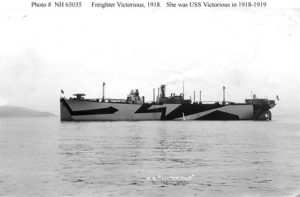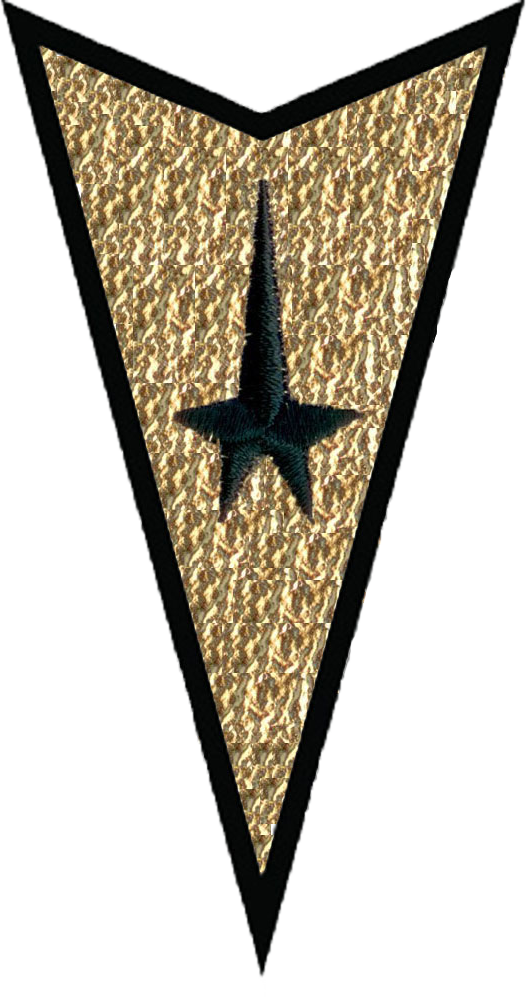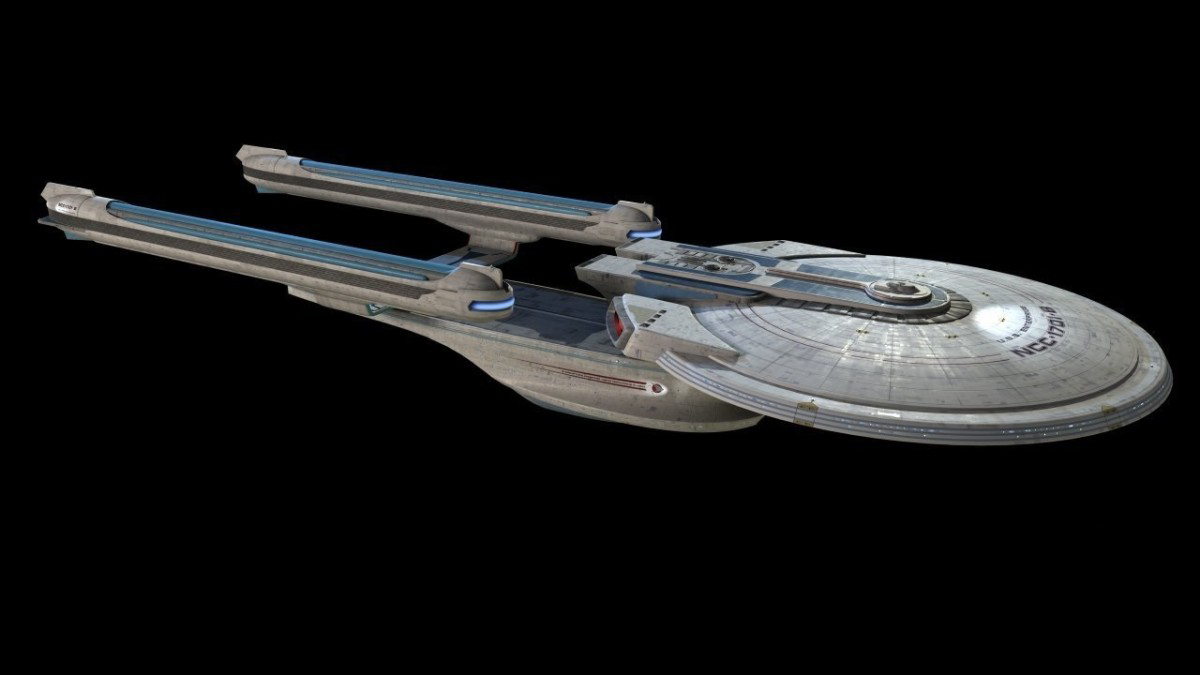History of USS Victorious
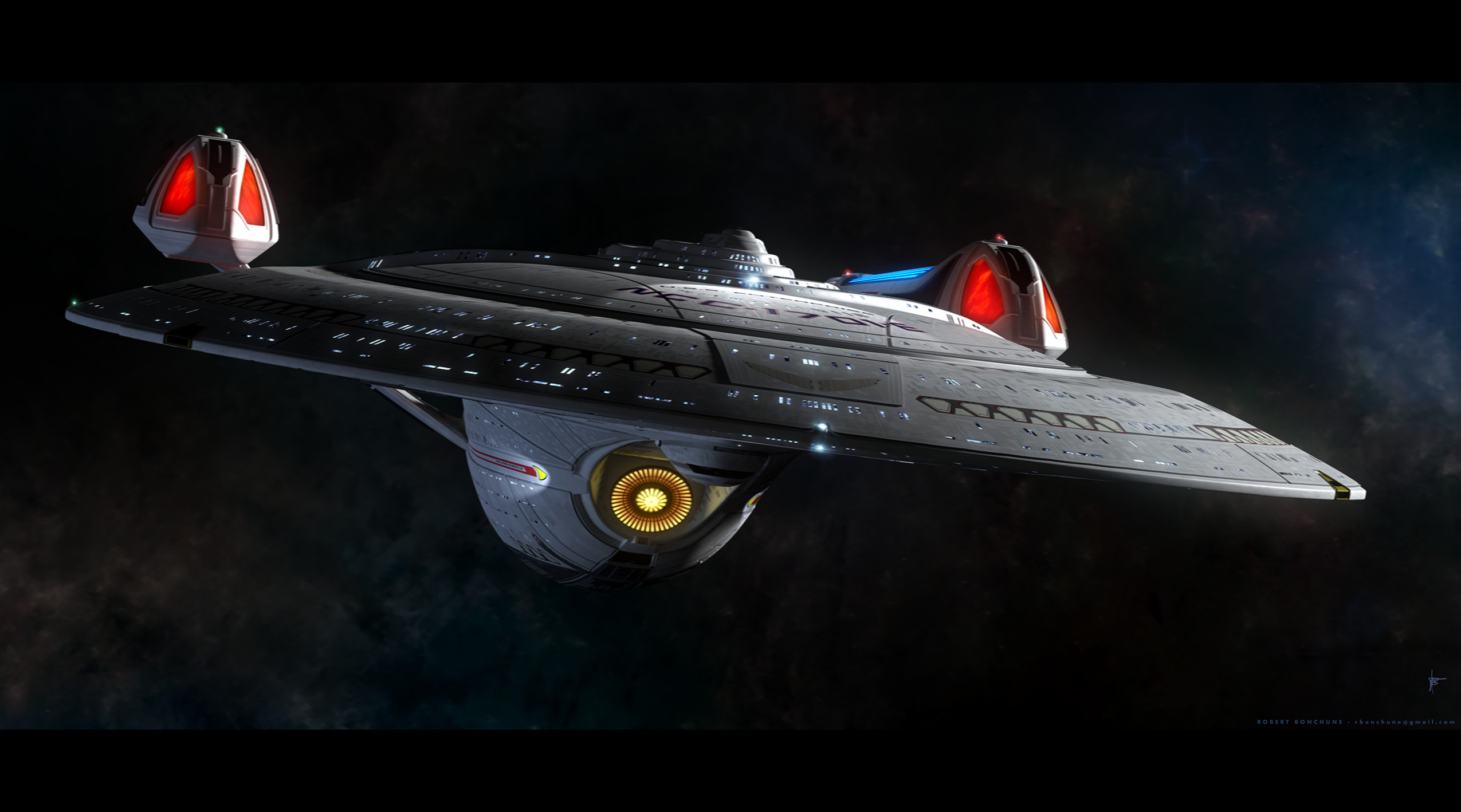
The current Victorious is a Sovereign class vessel. Commissioned on the 11th of December 2378. The Captain and crew of the of the Excelsior class USS Victorious were reassigned to the newly constructed Sovereign class USS Atlantis. Starfleet Operations grants special dispensation to change the name to USS Victorious in honor of its predecessors 50 years of service. USS Victorious was assigned to the Genesis Fleet as Flag ship of the fleet. The USS Victorious is currently assigned to STARFLEETs Second Fleet. This Sovereign class ship has been modified for command duties. Like its predecessor, this Victorious has a flag bridge and a combat information center (CIC) and extensive backups and redundancies for all tactical systems.
History of ships named Victorious
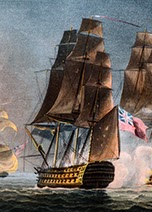
The first ship to carry the name Victorious was a 3rd rate British warship the 74 gun ship of the line HMS Victorious. Third Rate, The most numerous line-of-battle ships were the two decker Third Rates of between 64 and 80 guns. The most effective and numerous of these was the 74-gun ship: an ideal compromise of economy, fighting power and sailing performance. These formed the core of the battle fleet. They carried 32-pounders on the gun deck and 18-pounders on the upper deck, with a crew of 600-650 men. There were two ships of this class that carried the name Victorious, the first came into service in 1785. In 1799 this Victorious saw extensive service in the East Indies under the command of Capt. W. Clark. In 1803 the ship saw the end of her service and was broken-up. The second 74 gun H.M.S. Victorious came into service in 1808 as a Swiftshure class 74 gun third rate. In 1811 she saw service in the Mediterranean under the command of Capt. John Talbot. In 1814 she saw service in Americas. She was placed out of Commission in 1815 at Portsmouth. From 1822-1862 this Victorious saw service as a receiving ship in Portsmouth. She was broken-up in 1862.
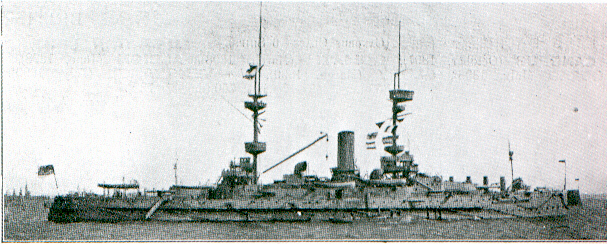
This Victorious was laid down in May of 1894 and completed in 1897 the HMS Victorious was classified as a Majestic class battleship. There were 8 other ships of this class: the Majestic, Magnificent, Hannibal, Prince George, Caesar, Mars, Jupiter and Illustrious. Furious and Majestic class ships were both conceived by Lord Fisher as large light cruisers designed to run into the Baltic to support an amphibious landing on the Kaiser’s German north shore. They outweighed some battleships and, though having only two main guns, they had the largest naval artillery afloat when built. These “cruisers” were the test-bed for the new 18″ guns that would go aboard the “Saints” class which were under construction. Somewhat unwanted as Royal Navy gun ships, Furious became converted to an aircraft carrier. Victorious was redesignated as a “light battlecruiser”, a somewhat doubly derisive term in view of the British experience with even moderately-armored battlecruisers in the First World War and offered for sale to any “friendly” nation. There were no takers for a long time. Victorious was sold to Australia in 1938 to help bolster her Far East naval forces against an increasingly hostile Japan. The British wanted the name “Victorious” for a new CV then building, so the Aussies shortened the name to Victoria, a former Queen and a region of that island continent. When she arrived she had the largest Allied guns afloat in the Far East, and the Aussies claimed that the presence of such ordnance led Japan to hasten the 20″-gunned Satsuma-class ships to meet the threat. Victoria was called out to search for German pocket battleships reportedly raiding the Arabian Sea oil tankers. She met up with the Admiral Scheer, and the fight was on. The “overly endowed light cruiser” had a margin of speed and explosive firepower over the pocket battleship, but rather less armor, less volume of fire, and lacked the ranging radar that enabled quick acquisition of the target. Scheer’s high volume of radar-directed fire created good hits early in the engagement . An “over” from Victoria smashed Scheer’s radar apparatus, but Scheer had the range down and hit Victoria amidships with several shells in one salvo, breaking her absurdly unprotected hull in two.
Heywood Class Transport:
Laid down in 1918 at as SS War Haven at Bethlehem Steel Corp., Alameda, CA. for the United States Shipping Board (USSB).
Completed for the USSB and acquired by the US Navy, 19 October 1918.
Acquired by the US Navy and commissioned USS Victorious (ID-3514), 21 October 1918.
Decommissioned and simultaneously struck from the Naval Register, 24 February 1919, at New York.
Returned to the United States Shipping Board for disposal.
Acquired by the Baltimore Mail S.S. Co. in 1931, renamed SS City of Havre, lengthened and passenger accommodations added.
Acquired by Panama Pacific Lines in 1938, and renamed SS City of Los Angeles.
Acquired by the US Navy, 30 October 1940.
Converted to a Naval Transport.
Commissioned USS George F. Elliott (AP-13), 10 January 1941, CAPT. Harry G. Patrick in command.
During World War II USS George F. Elliott was assigned to the Asiatic-Pacific Theater and participated in the following campaign;
Asiatic-Pacific Campaigns Guadalcanal-Tulagi landings, 7 to 9 August 1942.
Lost to enemy action, 8 August 1942, in Iron Bottom Sound during the invasion of Guadalcanal.
Struck from the Naval Register, 2 October 1942
USS George F. Elliott was awarded one battle star for World War II service.
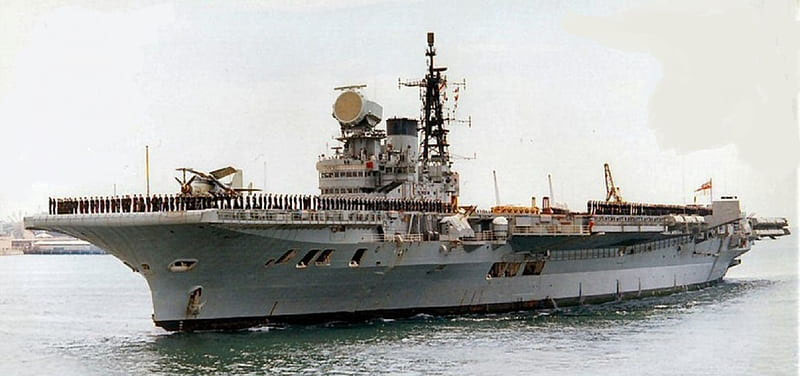
This Victorious was built by Vickers Armstrong, Newcastle. Laid down 4 May 1937. Launched 14 September 1939. Commissioned 15 May 1941. Took part in the Bismark chase soon after commissioning. Refitted at Norfolk Navy Yard USA, winter 1942-43, after which she was loaned to the US Pacific Fleet until being replaced by USS Essex. British Pacific Fleet 1945: hit by two kamikazes, repaired in Australia. Reconstructed October 1950 – January 1958, ship rebuilt from hangar deck upwards with angled flight deck and large increase in hangar height: Displacement: 30,530 tons standard, 35,500 tons fully loaded. Dimensions: 781 LOA x 103.25 x 31 feet beam. Propulsion: reboilered. Compliment: 2200 (including air group) Aircraft: 35 including Sea Vixens and Buccaneers. Guns: 6x twin 3 inch / 50 ; 6x 40 mm AA. Radar: 3D Fighter-control ( Type 984, used to control the Buccaneers) Height Finding – Type 293Q ; Navigation – Type 974. Refitted 1960. Damaged by fire during 1967 refit when it was decided that she should be decommissioned early. July 1969.
HISTORY OF HMS VICTORIOUS AIRCRAFT CARRIER
Following the news that Bismarck and Prinz Eugen were in the Norwegian Sea and heading for the North Atlantic convoys, Victorious left Scapa Flow with the Home fleet on May 22nd 1941. On board were 800Z Fulmars and 825 Swordfish squadrons. Attacked Bismarck, May 24th 1941, damaging the boiler room and thus reducing her speed. Left for refueling in Clyde
August 11th 1942: Operation Pedestal. One of the largest convoys in the Malta campaign. Shipping 38 Spitfires to help allied troops and stop an axis blockade of Malta
November 1942: Operation Torch. Escorted landing craft to French North Africa May – September 1943: Became part of the US fleet due to heavy losses after Pearl Harbor
April 3rd 1944: Operation Tungsten. Search and destroy Tirpitz. Attack caused Tirpitz to be out of action for 6 months, with few allied casualties
July 25 1944: Joined Indomitable and Illustrious for a strike against Sabang
August 24 1944: Operation Banquet. Padang, Sumatra
September 18 1944: Operation Light. Sigli, Sumatra
October 17th 19th 1944: Operation Millet. Nicobar islands.
During these operation no counter attacks were mounted against the strike force until October 19th when Corsairs from Victorious downed eight defending enemy aircraft without loss
November 22nd 1944: Became part of the British Pacific Fleet
January 4th 1945: Inflicted considerable damage to the Belawan Deli docks, Sumatra
January 24th 29th Part of the largest British carrier strike operation of WWII involving 249 aircraft in four carriers, achieving the total destruction of the Pangkalan oil refinery in Sumatra, as well as 37 Japanese aircraft.
May 9th 1945: Hit twice by kamikaze fighters.
July 1945: returned to Manus to prepare for attacks on the Japanese mainland island of Honshu.
August 11th 1945: Withdrawn from further active service in WWII
Took part in the MacArthur landings in New Georgia
Reconstructed during 1950-58 to carry jet fighters. Housed the 885 Sea Hurricane squadron after re-fit.
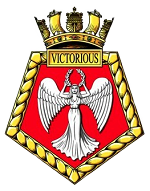
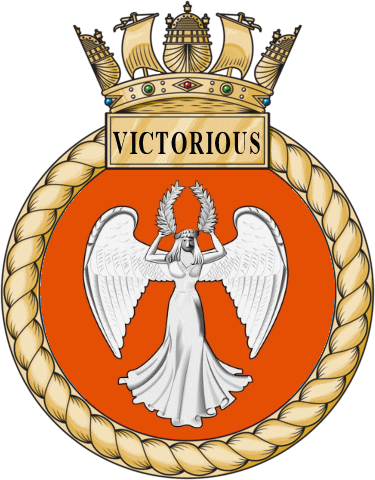
A couple ship crests Badges from this era.
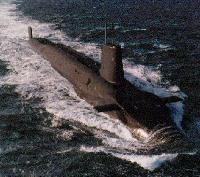
Shown at left is the Fifth HMS Victorious, a Vanguard class nuclear submarine in the British Royal Navy. HMS Victorious was commissioned in 1995. The first of this class of submarine was the HMS Vanguard. The Vanguard was commissioned in 1993. There were 2 other ships of this class the HMS Vigilant and the HMS Vengeance. Length: 491 feet. Hull diameter: 43.3 feet. Height: 4 stories. Displacement: 16,000 tones submerged. Speed: 25 knots submerged. Power plant: 1 pressurized water PWR-2 nuclear reactor, geared steam turbines, 1 shaft Crew: 132 Armaments: 4 torpedo tubes for Spearfish torpedoes, 16 Trident-II D5 SLBMs carrying a maximum of 96 Mk-4/100-kt MIRVs Armed with sixteen Trident missiles, the Victorious was the backbone of Great Britain’s nuclear deterrent. She underwent her first missile drills in July of 1995. No additional information is available on this vessle due to the world conflict and the lose of records.
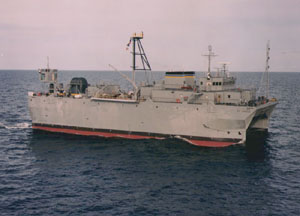
The USNS Victorious was a sonar-towing anti-sub warfare vessel served in the United States Navy. Her split-hull design is geared for operation in rough northern seas. She is the class ship of the T-AGOS 19 design, and served in the Pacific Fleet. No Additional information available.
Builder: McDermott Marine, Morgan City, Lou. Power Plant: Diesel electric, twin shaft, 1,600 shaft horsepower Length: 234 feet (72 meters) Beam: 94 feet (28 meters) Displacement: 3,396 tons (3,087metric tons) Speed: 16 kts (18.4 mph, 29.6 kph) Other class ships: USNS Victorious (T-AGOS 19), USNS Able (T-AGOS 20), USNS Effective (T-AGOS 21), USNS Loyal (T-AGOS 22) Crew: 22 civilians and 12 Navy personnel
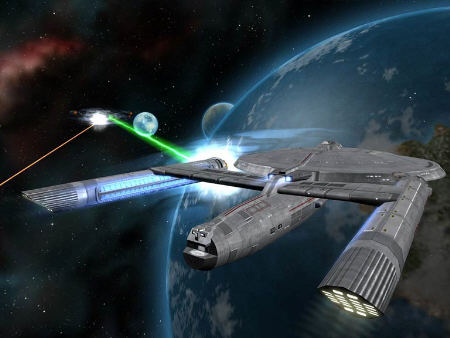
In late 2182 to a Baton Rouge class space cruiser. These vessels were the immediate predecessor to the Constitution class and were in service from 2170-2210. This USS Victorious was decommissioned in 2186 after being severely damaged in a ion storm. Length 245 meters. Beam 153 meters. Draught 64.6 meters. Mass 92.5 million kg. Ship’s Complement 344. Cruising Velocity Warp 6.5. Maximum Velocity Warp 6.8. Weapons 4 Phaser Cannon banks, 2 particle beam cannons and 1 photon torpedo tube.
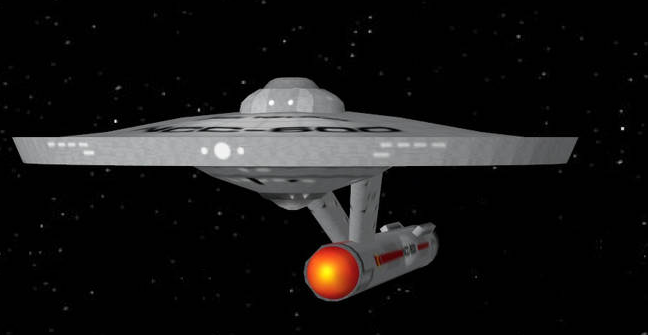
The next vessel to carry the name Victorious was a Nelson class scout NCC 2364. The Nelson class scouts primary mission was to explore and map uncharted areas of space, to observe new civilizations and cultures, and in some cases, to make initial contact. This made the Nelson class scout responsible for more contacts with alien cultures than any other vessel class in its time. This USS Victorious was commissioned on 22nd July 2242. She was destroyed on 18th of November 2262 with over 80% of her crew lost. Length 263 meters. Width 127 meters. Height 61 meters. Weight 79,700 metric tons. Ship’s Complement 190. Cruising Velocity Warp 7. Maximum Velocity Warp 8. Weapons 2 forward phaser banks.
The previous Victorious was an Excelsior class vessel. Originally commissioned on the 4th of November 2328 This USS Victorious had many years of service. With extensive modifications being made after contact with threats such as the Borg and the Dominion, Starfleet took a new approach to starship design. The only line of defense, it seemed, was a new class of dreadnought to supplement the Galaxy Class, a design that had itself proven ineffective in combat against smaller tactical craft. The loss of the Odyssey to Jem’Hadar forces in the Gamma Quadrant, and the later loss of the Enterprise to a single Bird of Prey proved this point. However, a new class of starship was not cost-effective.
An officer at Starfleet Tactical proposed a refit of aging Excelsior class vessels was possible using current technology. By replacing the warp drive with the more efficient “green” engines, similar to the one used in the Intrepid class, and adding a secondary warp core from a scout class vessel to the power grid, a 35% power increase was achieved. The Victorious, an older vessel that saw extensive service during the Cardassian War, was selected as the first ship to undergo the Mk-XII B refit.
Many of the amenities customary aboard a Starfleet vessel were replaced with more combat-oriented fixtures. Gone were family quarters, laboratories, and recreation facilities. The Victorious was host to six runabouts and can also deploy small tactical combat craft. She was also equipped to deploy ground forces and support craft to a hostile landing zone. Designed with command duties in mind, there was a flag bridge, combat information center (CIC), and extensive backups and redundancies for all tactical systems. Victorious was armed with a new hybrid integrated phaser-disrupter system generating more than 25% more power on a wider frequency bandwidth than traditional weapons systems. She was also armed with “megaphaser” emplacements and quantum torpedoes, like those used on the Defiant, and tri-cobalt devices like those from the Intrepid class. The ship was designed for combat from the keel up. The operational mission duration was shorter, with average missions lasting around 120 days. Length 470.68 meters. Width 177.21 meters. Height 78.86 meters. Weight 405,072 metric tons. Ship’s Complement 873. Cruising Velocity Warp 8.6. Maximum Velocity Warp 9.35. On the 28th of November 2378 the Excelsior class USS Victorious was destroyed by hostile action, with the details of this incident having been classified by Starfleet Command.
This Information researched and compiled by C. Mark Anderson and David E. Lowe.
